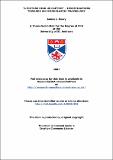Files in this item
"A picture held us captive" : investigations towards an iconoclastic praxeology
Item metadata
| dc.contributor.advisor | Partridge, Michael Francis | |
| dc.contributor.author | Deary, Janice L. | |
| dc.coverage.spatial | viii, 266 | en |
| dc.date.accessioned | 2007-12-11T11:58:45Z | |
| dc.date.available | 2007-12-11T11:58:45Z | |
| dc.date.issued | 2007 | |
| dc.identifier | uk.bl.ethos.552068 | |
| dc.identifier.uri | https://hdl.handle.net/10023/398 | |
| dc.description.abstract | Iconoclastic discourse, as a critique of ‘idols’ of various kinds, has been appropriated by a range of different thinkers and traditions – often not always explicitly religious – throughout history. One of the more recent targets of iconoclasm is metaphysics, understood as a way of doing philosophy that appeals to an ideal or transcendent ground that is used to offer a totalising explanation of ‘reality’. For some reason, the issue of ‘metaphysical idolatry’ has become entangled with the problem of ‘writing’, or ‘representation’ more generally, which is pictured in some rather strange ways by a range of thinkers and theorists – including philosophers and theologians such as Jacques Derrida, Jean-Luc Marion, and Catherine Pickstock – in order to either challenge, or to be held accountable for, the ‘idolatry’ of metaphysical thought. It seems, however, that these strange pictures of writing compound rather than solve the problem of metaphysics, and it is towards pictures such as these that we direct our own iconoclastic critique. What many critics of metaphysics have failed to comprehend, we argue, is that metaphysics is a certain type of philosophical practice, and it must therefore be judged from this perspective. Idolatry itself has, since biblical times, been understood as a form of sinful practice, and unless we understand iconoclastic problems in a praxeological way, we risk basing our critical arguments on delusional assumptions. We turn to the work of thinkers as diverse as Marx, Wittgenstein, Heidegger, Merleau-Ponty, Ryle, Bourdieu, Ingold, and others, who have challenged metaphysics, and the strange pictures that metaphysical thought has inspired, through the adoption of what we call a praxeological approach. It is from this perspective, we argue, that we can make iconoclastic judgements, and justify these judgements, in a way that avoids the speculative conundrums of some other more problematic approaches. | en |
| dc.format.extent | 2405270 bytes | |
| dc.format.mimetype | application/pdf | |
| dc.language.iso | en | en |
| dc.publisher | University of St Andrews | |
| dc.rights | Creative Commons Attribution-NonCommercial-NoDerivs 3.0 Unported | |
| dc.rights.uri | http://creativecommons.org/licenses/by-nc-nd/3.0/ | |
| dc.subject | Iconoclastic discourse and practice | en |
| dc.subject | Post-metaphysical continental philosophy and theology | en |
| dc.title | "A picture held us captive" : investigations towards an iconoclastic praxeology | en |
| dc.type | Thesis | en |
| dc.type.qualificationlevel | Doctoral | en |
| dc.type.qualificationname | PhD Doctor of Philosophy | en |
| dc.publisher.institution | The University of St Andrews | en |
This item appears in the following Collection(s)
Except where otherwise noted within the work, this item's licence for re-use is described as Creative Commons Attribution-NonCommercial-NoDerivs 3.0 Unported
Items in the St Andrews Research Repository are protected by copyright, with all rights reserved, unless otherwise indicated.


